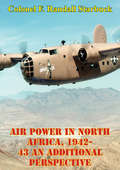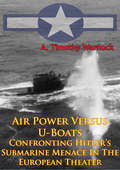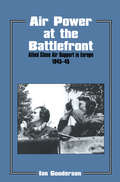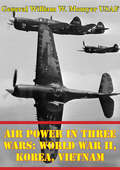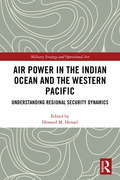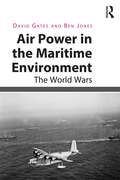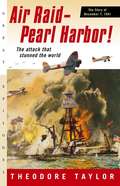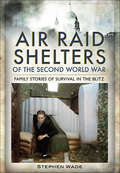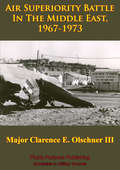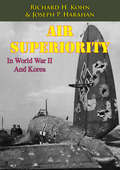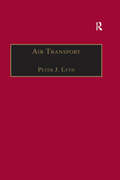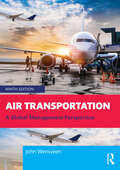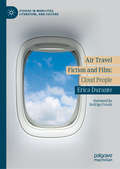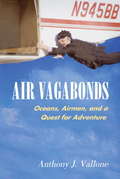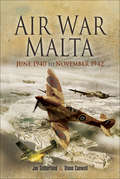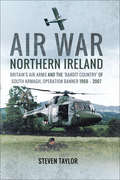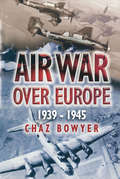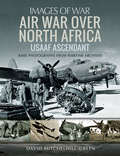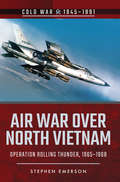- Table View
- List View
Air Power In North Africa, 1942-43: An Additional Perspective
by Colonel F. Randall StarbuckThe hastily mounted invasion of French Northwest Africa in November of 1942 was a gamble. It exposed American inexperience. That inexperience went from Roosevelt on down to the soldier in the foxhole. Half-trained men were pitted against Vichy France and didn't know whether to expect open arms or open fire. Later, those same inexperienced men would meet Rommel at the Kasserine Pass. This naivete was exhibited by both men and leaders. Torch was Eisenhower's first major operation--a gigantic airlift and sealift preceded by months of intrigue. The outcome of the campaign settled several air power issues and revealed many lessons. The battles fought by the United States forces during the North African Campaign of 1942 and 1943, particularly the Battle for the Kasserine Pass in February 1943, were a breaking and testing ground for much of the employment of those forces during the remainder of the Second World War. Three air power key lessons were learned on the North African battlefield. First was the need for coordination between air and ground forces. Second was the folly of sending untrained airmen into combat. Third was the importance of tactical air targeting by ground force commanders.
Air Power Supremo: A Biography of Marshal of the Royal Air Force Sir John Slessor
by William PykeSir John Slessor was one of the twentieth century’s most distinguished wartime commanders and incisive military thinkers, and William Pyke’s comprehensive new biography reveals how he earned this remarkable reputation. Slessor, a polio victim who always walked with a stick, became a First World War pilot in the Sudan and on the Western Front and a squadron and wing commander in India between the wars. When aerial warfare was still a new concept, he was one of the first to develop practical tactics and strategies in its application. In the Second World War, as the Commander-in-Chief of Coastal Command during the Battle of the Atlantic and the RAF in the Mediterranean during the Italian and Balkan campaigns, he made a remarkable contribution to the success of Allied air power. Then, after the war, as a senior commander he established himself as one of the foremost experts on strategic bombing and nuclear deterrence. That is why this insightful biography of a great British airman and his achievements is so timely and important as we enter a new era of strategic doubts and deterrence at the beginning of the twenty-first century. William Pyke follows each stage of Slessor’s brilliant career as a pilot and commander in vivid detail. In particular he concentrates on Slessor’s writings, from his treatise on the application of air power in support of land armies to his thinking on nuclear deterrence and Western strategy.
Air Power Versus U-Boats - Confronting Hitler’s Submarine Menace In The European Theater [Illustrated Edition]
by A. Timothy WarnockIncludes over 14 photos and mapsMore than fifty years after World War II, America's major air power contribution to the war in Europe-in efforts such as Big Week, Regensburg, and Patton's dash across Europe-live on in the memories of airmen and students of air power. Never before had air forces performed so many roles in so many different types of operations. Air power proved to be extremely flexible: wartime missions included maintaining air superiority, controlling the air space over the battlefield; strategic bombardment, destroying the enemy's industrial and logistical network; air-ground support, attacking targets on the battlefield; and military airlift, delivering war materiel to distant bases.Perhaps one of the least known but significant roles of the Army Air Forces (AAF) was in antisubmarine warfare, particularly in the European-African-Middle Eastern theater. From the coasts of Greenland, Europe, and Africa to the mid-Atlantic, AAF aircraft hunted German U-boats that sank thousands of British and American transport ships early in the war. These missions supplemented the efforts of the Royal Navy, the Royal Air Force Coastal Command, and the U.S. Navy, and helped those sea forces to wrest control of the sea lanes from German submarines.
Air Power at the Battlefront: Allied Close Air Support in Europe 1943-45 (Studies in Air Power #Vol. 6)
by Dr Ian GoodersonIan Gooderson presents a study of close air support in World War II, with the analysis focusing on the use of tactical air power by British and American forces during the campaigns in Italy and northwestern Europe between 1943 and 1945.
Air Power in Three Wars: World War II, Korea, Vietnam [Illustrated Edition]
by General William W. Momyer USAF[Includes over 130 illustrations and maps]This insightful work documents the thoughts and perspectives of a general with 35 years of history with the U.S. Air Force - General William W. Momyer. The manuscript discusses his years as a senior commander of the Air Force - strategy, command and control counter air operations, interdiction, and close air support. His perspectives cover World War II, the Korean War and the Vietnam War.
Air Power in the Age of Total War (Warfare and History)
by John BuckleyWarfare in the first half of the 20th century was fundamentally and irrovocably altered by the birth and subsequent development of air power. This work assesses the role of air power in changing the face of battle on land and sea. Utilizing late-1990s research, the author demonstrates that the phenomenon of air power was both a cause and a crucial accelerating factor contributing to the theory and practice of total war. For instance, the expansion of warfare to the homefront was a direct result of bombing and indirectly due to the extent of national economic mobilization required to support first rate air power status. In addition, the move away from the principle of total war with the onset of the Cold War and the replacement of air power by ICBMs is thoroughly examined. This work should provide students of international history, war studies, defence and strategic studies with an insight into 20th-century warfare.
Air Power in the Falklands Conflict: An Operational Level Insight into Air Warfare in the South Atlantic
by John ShieldsFrom the television footage shown in all its stark reality and the daily coverage and subsequent memoirs, the impression delivered from the air battles in the Falklands Conflict was that of heroic Argentine pilots who relentlessly pressed home their attacks against the British. While, by contrast, there is a counter-narrative that portrayed the Sea Harrier force as being utterly dominant over its Argentine enemies. But what was the reality of the air war over the Falkland Islands? While books on the air operations have published since that time, they have, in the main, been personal accounts, re-told by those who were there, fighting at a tactical level, or back in their nation’s capital running the strategic implications of the outcome. But a detailed analysis of the operational level of the air war has not been undertaken – until now. At the same time, some analysts have inferred that this Cold War sideshow offers little insight into lessons for the operating environment of future conflicts. As the author demonstrates in this book, there are lessons from 1982 that do have important and continued relevance today. Using recently released primary source material, the author, a serving RAF officer who spent two-and-a-half years in the Falklands as an air defence navigator, has taken an impartial look at the air campaign at the operational level. This has enabled him to develop a considered view of what should have occurred, comparing it with what actually happened. In so doing, John Shields has produced a comprehensive account of the air campaign that has demolished many of the enduring myths. This is the story of not why, but how the air war was fought over the skies of the South Atlantic.
Air Power in the Indian Ocean and the Western Pacific: Understanding Regional Security Dynamics (Military Strategy and Operational Art)
by Howard M. HenselThis book examines the security dynamics of the Indian Ocean and the Western Pacific, concentrating upon an analysis and evaluation of the air power capabilities of the various powers active in the two regions. The volume is designed to help improve understanding of the heritage and contemporary challenges confronting the global community in the Indian Ocean and the Western Pacific, as well as to illuminate the policies of the various powers involved in the affairs of these regions, and the military capabilities that are available in support of those policies. The 16 individual chapters examine both the traditional and the non-traditional threats that confront the various Indian Ocean and Western Pacific powers, and assess the roles played by land-based and naval, fixed-wing and rotary-wing, manned and unmanned aircraft, as well as by offensively and defensively capable ballistic and cruise missiles in addressing these challenges. In doing so, the various chapters analyze and evaluate the air power doctrine, capabilities, deployment patterns, and missions of the respective states. In addition, they assess the future issues, challenges, and responses involving air power as it, acting in concert with other military instruments, seeks to contribute to securing and promoting the interests of the state. This book will be of much interest to students of air power, strategic studies, Asian and Middle Eastern politics, and International Relations.
Air Power in the Maritime Environment: The World Wars
by Ben Jones David GatesThis book explores the mingling of two rather different perspectives, those of the naval and aeronautical schools of thought, and the impact that they had upon one another in natural, professional and geopolitical settings. To explain the manner in which air power was incorporated into warfare between 1914 and 1945 it studies the deeds of practitioners, the limitations of technology, the realities of combat and the varying institutional dynamics and strategic priorities of the major maritime powers. It is underpinned by an appreciation of the geostrategic setting of the key maritime states, while addressing the challenges of operating in this multifaceted environment and the major technological developments which enabled air power to play an ever greater role in the maritime sphere. The potential for air power to influence warfare in the maritime environment was fully realised during the Second World War and its impact is demonstrated through an analysis of a wide range of the fleet operations and how it was utilised in the defence of trade and sea lanes. As such this book will be of interest to both naval and air power historians and those wanting a fuller perspective on maritime strategy in this period.
Air Raid -- Pearl Harbor!: The Story of December 7, 1941
by Theodore TaylorIt examines from both the American and Japanese points of view the political and military events leading up to the attack on Pearl Harbor.
Air Raid Shelters of the Second World War: Family Stories of Survival in the Blitz
by Stephen WadeThis book features the design, creation and use of air raid shelters, including interviews with people who used them during the Second World War. The different types of bunkers/air raid shelters (both public and in peoples gardens) are covered and the strength and weakness of their designs discussed, using original designs and primary material. The nostalgia/social history of the book covers peoples experiences of staying in the air raid shelters. These are divided into topics, including getting to the shelters (how they reacted to the sirens or whether they just moved into the shelters, especially those in gardens, long-term), facilities, health issues, morale and safety, both real and perceived. In recent years, air raid shelters have been converted into different uses, including homes, and the book will finish with a brief chapter concerning the future and preservation of these once vital buildings.
Air Raids on South-West Essex in the Great War: Looking for Zeppelins at Leyton
by Alan SimpsonA quarter of a century before the Blitz of 1940, the inhabitants of south-west Essex were terrorized by an earlier aerial menace. Over the course of four years, German Zeppelins, Gothas and Giants flew above their homes, unleashing hundreds of highly explosive and incendiary bombs on London. During three of these raids, bombs were dropped on Leyton and many others landed elsewhere in south-west Essex. These early air raids are now largely forgotten in local memory, but for the inhabitants of the time the attacks were unprecedented, unexpected and lethal.In the years since the Great War a great deal of literature has been published on London's first air raids and about the defence network that evolved around the metropolis, but what happened in the capital's eastern suburbs and the nearby Essex countryside has received less coverage. This meticulously researched and insightful book attempts to put that right, looking at the area which, in 1914, was part of south-west Essex, but now comprises the London boroughs of Waltham Forest, Redbridge, Havering, Newham, and Barking and Dagenham.Focussing in particular on Leyton and Ilford, this is the first book to ever examine what happened before and after the raiders reached and bombarded the capital. The author has included a wide range of contemporary letters, diaries and newspaper reports from local sources, plus several previously unseen photographs. To set the story in its wider context, the book also contains a wealth of information about the defence of the London area generally and vivid reports from combatants on both sides.
Air Superiority Battle In The Middle East, 1967-1973
by Major Clarence E. Olschner IIIThis paper is an historical study of the strategy, tactics, and weapons employed by Israel, Egypt, and Syria in the battle for air superiority from 1967 through 1973. The study is developed chronologically beginning with the 1967 War, through the War of Attrition, and ending with the cease-fire in the 1973 War. It has been compiled from an extensive review of unclassified, primarily secondary, unofficial sources. The paper concludes that, in a mid-intensity war with modern air forces and air defense forces: 1) The achievement of strategic, tactical, and/or technological surprise can significantly influence the battle for air superiority, 2) Missiles have demonstrated the capability to significantly influence the air superiority battle in surface-to-air, air-to-air, and air-to-ground operations, 3) Air superiority can be achieved over the modern battlefield only by defeating both surface-to-air and air-to-air capabilities of the enemy, 4) The achievement of air superiority over the battle area requires the combined efforts of air and land forces of which long range artillery may be the most effective weapon for the suppression of surface-based air defenses.
Air Superiority In World War II And Korea [Illustrated Edition]
by Joseph P. Harahan Richard H. KohnIncludes over 20 illustrations.In November 1981, Lt. Gen. Hans H. Driessnack, Assistant Vice Chief of Staff, asked the Historical Program to assemble a small number of retired officers for a group oral history interview. General Driessnack believed that in reminiscing together, these officers would recall incidents and experiences that might otherwise go unrecorded; by exchanging ideas and questioning each other--in effect, interviewing each other--they would recall material that would be of interest and importance to the Air Force today. General Driessnack also suggested selecting retired officers from the senior statesman conference, a gathering every spring at which retired four-star generals are briefed on Air Force issues and then discuss them with contemporary Air Force leaders.The result is the following interview. The four participants--Gen. James Ferguson, Gen. Robert M. Lee, Gen. William W. Momyer, and Lt. Gen. Elwood R. "Pete" Quesada--gathered on May 21, 1982, around a table in the Vandenberg room at the Bolling Air Force Base Officers' Club. For approximately two and one half hours they responded to questions sent to them earlier and discussed air superiority in World War II and Korea. Their discussions ranged far and wide: flying in the pre-World War II Army Air Corps, campaigning in North Africa and Western Europe in World War II, planning and participating in the Normandy invasion, using secret intelligence supplied by Ultra, struggling to codify tactical air doctrine in the post-war years, fighting the air battle in Korea, and thinking about the general problem of air superiority throughout their careers. This collective interview is not history but the source material on which history rests; it is a memoir, a first-hand account by air leaders who flew, fought, and commanded tactical air forces in combat.
Air Supply Operations In The China-Burma-India Theater Between 1942 And 1945
by Major Adrian Rainier ByersThe USAAF responded to the requirement to keep China engaged against Japan by conducting two distinct air supply operations, a tactical air supply mission to Burma and a strategic air supply effort over the Himalayas to China. The tactical air supply effort to Burma supported offensive combat operations and the construction of the Ledo Road, while the Hump airlift directly contributed to the American strategic objective. Despite Stilwell's stubborn commitment to the Ledo Road as the main effort to supply the Chinese and to the necessary use of tactical air supply to support this and other ground operations in Burma, the key contribution to the success of keeping China in the war against Japan was ultimately the strategic air supply missions over the Hump. This thesis reviews how the operational airlift efforts within the CBI supported both efforts and examines the challenges, processes, and development of air supply. The fundamental question associated with this effort concerns how the USAAF responded to seemingly competing air supply requirements in the CBI Theater in order to keep China in the war against Japan.
Air Transport: European Commercial Air Transport Since 1945 (Studies in Transport History)
by Peter J. LythEach volume in this new series is a collection of seminal articles on a theme of central importance in the study of transport history, selected from the leading journal in the field. Each contains between ten and a dozen articles selected by a distinguished scholar, as well as an authoritative new introduction by the volume editor. Individually they will form an essential foundation to the study of the history of a mode of transport; together they will make an incomparable library of the best modern research in the field.
Air Transportation: A Global Management Perspective
by John WensveenNow in its ninth edition, Air Transportation: A Global Management Perspective by John Wensveen is a well-proven, accessible textbook that offers a comprehensive introduction to the theory and practice of air transport management. In addition to explaining the fundamentals, the book transports the reader to the leading edge of the discipline, using past and present trends to forecast future challenges and opportunities the industry may face, encouraging the reader to think deeply about the decisions a manager implements. The word "Global" has been added to the subtitle for this edition, reflecting an increased emphasis on worldwide operations, including North America, Latin America/Caribbean, Europe, Asia-Pacific, the Middle East, and Africa. The ninth edition focuses on the "Age of Acceleration," addressing trends related to emerging technologies, such as autonomy, artificial intelligence, augmented reality, virtual reality, 3-D printing, data analytics, blockchain, cybersecurity, etc. New material includes extra information on airport management and operations, air carrier business models, aviation risk, safety and security, and how changing political landscapes impact the aviation industry. Enhanced content is supported by the addition of new chapters and online supplemental resources, including PowerPoint presentations, chapter quizzes, exam questions, and links to online resources. This wide-ranging textbook is appropriate for nearly all aviation programs that feature business and management. Its student-friendly structure and style make it highly suitable for modular courses and distance-learning programs, or for self-directed study and continuing personal professional development.
Air Travel Fiction and Film: Cloud People (Studies in Mobilities, Literature, and Culture)
by Erica DuranteAir Travel Fiction and Film: Cloud People explores how, over the past four decades, fiction and film have transformed our perceptions and representations of contemporary air travel. Adopting an interdisciplinary approach, the book provides a comprehensive analysis of a wide range of international cultural productions, and elucidates the paradigms and narratives that constitute our current imaginary of air mobility. Erica Durante advances the hypothesis that fiction and film have converted the Airworld—the world of airplanes and airport infrastructures—into a pivotal anthropological place that is endowed with social significance and identity, suggesting that the assimilation of the sky into our cultural imaginary and lifestyle has metamorphosed human society into “Cloud People.” In its examination of the representations of air travel as an epicenter of today’s world, the book not only illustrates a novel perspective on contemporary fiction, but fills an important gap in the study of globalization within literary and film studies.
Air Vagabonds
by Anthony J. ValloneAir Vagabonds is the story of the amazing, true (mis)adventures of a band of rogues piloting aircraft alone into exotic and deadly destinations.In the late 1970s and through the 1980s the demand for light aircraft eclipsed anything seen before or since. This created the need for a small air force of pilots--ferry pilots--willing to fly thousands of planes to clients in every corner of the globe. Long-range solo flying is not for everyone, and it attracted a cast of eccentric, unforgettable mavericks who flew from one misadventure to the next, battling storms, desert winds, aircraft malfunctions, primitive navigational aids, loneliness, chemical imbalances, and dangerous Third World politics. Some carried on international scams and love affairs, some were lost at sea, some imprisoned by African despots. They're all here, described with humor and high drama by one of their own, a survivor with phenomenal recall, a knack for distinguishing character from bluster, and a great ear for dialogue and aviation lore.
Air War Iraq (Battlefield Britain Ser.)
by Tim RipleyThe book is a photo-journalistic record of the vitally important role that aviation played in the recent liberation of Iraq. It follows the part that American, British and Australian airpower played in each theatre of the campaign. It includes the many different missions that aircraft were tasked with, precision bombing, support of ground forces, clandestine air drops. Covering the initial build-up to the rapid and record-breaking advance on the capital it uses dramatic action photographs and first-hand accounts to portray the events as they unfolded.
Air War Malta: June 1940 to November 1942
by Diane Canwell Jon SutherlandThis is the story of the historic air defense of Malta by the WRAF against the combined attacking forces of the Italian and German air forces. The island was poorly equipped when Italy declared war on Britain in June 1940 and its only defense against air attack at the outset of war were 34 heavy and 8 light antiaircraft guns, one radar set and four Gladiator biplane fighters. The first air raids came on 11 July and from then on were an almost daily feature of life for the Maltese occupants and the island was in a state of siege. The loss of this strategic point in the central Mediterranean would threaten the major supply routes to the British Army in North Africa and deprive the Royal Navy of a vital base. Although hard-pressed at home and standing alone against Hitlers Europe, every effort was made by Britains government to get supplies, munitions and replacement aircraft to enable the island to withstand the naval and airborne onslaught. Convoy after convoy attempted to get through, Hurricane and Spitfire fighters were launched from aircraft carriers with only sufficient fuel for a one-way trip to the island. Many did not survive these heroic flights. Many famous British ships were lost due to torpedo and air attack, including the carriers Ark Royal and Eagle and the battleship Barham. The siege was finally raised on 20 November 1942.This book follows the islands wartime history, describing the heavily outnumbered WRAF defense against the many air-raids and how the small bomber force took the battle to Italian shores. It is a tale of outstanding bravery by the British forces and the Maltese people.
Air War Northern Ireland: Britain's Air Arms and the 'Bandit Country' of South Armagh, Operation Banner 1969–2007
by Steven TaylorThe story of the little-known battles between British helicopters and Provisional IRA units equipped with heavy machine guns, RPGs, and SAMs—includes photos. Famously dubbed &“Bandit Country&” by a UK government minister in 1975, South Armagh was considered the most dangerous part of Northern Ireland for the British Army and Royal Ulster Constabulary during the years of violence known as the Troubles that engulfed the province in the last three decades of the twentieth century. This was also true for the helicopter crews of the RAF, Royal Navy, and Army Air Corps who served there. Throughout the Troubles, the Provisional IRA&’s feared South Armagh brigade waged a relentless campaign against military aircraft operating in the region, where the threat posed by roadside bombs made the security forces highly dependent on helicopters to conduct day-to-day operations. From pot-shot attacks with Second World War-era rifles in the early days of the conflict to large-scale, highly coordinated ambushes by PIRA active service units equipped with heavy machine guns, rocket-propelled grenade launchers and even shoulder-launched surface-to-air missiles (SAMs), the threat to British air operations by the late 1980s led to the arming of helicopters operating in the border regions of Northern Ireland. Drawing on a wide range of sources, including official records and the accounts of aircrew, this book tells the little-known story of the battle for control of the skies over Northern Ireland&’s &“Bandit Country.&”
Air War Over Europe, 1939–1945: 1939-1945
by Chaz BowyerChaz Bowyer, arguably the most authoritative air historian of his generation, tackles the broad sweep of air operations in the European theatre in this book. Initially, the Luftwaffe attempted to dominate the skies, and very nearly succeeded. The valiant defence of the UK by the RAF in the Battle of Britain ranks among the greatest feats of arms in our country's history. The development of aircraft types and the descriptions of the actions that they and their pilots and crew fought make for great reading.
Air War Over North Africa: USAAF Ascendant (Images of War)
by David Mitchelhill-GreenThe decisive role of U.S. Army Air Forces in North Africa is vividly chronicled in this WWII pictorial history featuring rare wartime photographs. In 1942, General Erwin Rommel launched a surprise offensive in North Africa that brought a renewed threat to the Allied forces in the Middle East. United States Army Air Forces were quickly transferred to Egypt to assist the beleaguered British. Unaccustomed to the sprawling deserts of North Africa, the American airmen were confronted by sandstorms, flooding rains, extremes of temperature and primitive living conditions. Beyond these daunting conditions, they were pitted against an experienced and determined enemy. U.S. air power nevertheless played a decisive role in the Allied invasion of Northwest Africa and the subsequent surrender of Axis forces in Tunisia in May 1943. Later bombing missions flown from North Africa struck Axis targets across Europe and supported the Allied invasions of Sicily and mainland Italy. Featuring rare photograph from wartime archives, this volume in the Images of War series presents an illustrated account of U.S. fighter aircraft and bombers—including the iconic B-17 Flying Fortress, P-38 Lightning and B-24 Liberator—and the aircrews that fought to establish ascendancy over North African skies and beyond.
Air War Over North Vietnam: Operation Rolling Thunder, 1965–1968 (Cold War, 1945–1991)
by Stephen EmersonIn early 1965 the United States unleashed the largest sustained aerial bombing campaign since World War II, against North Vietnam. Through an ever escalating onslaught of destruction, Operation Rolling Thunder intended to signal Americas unwavering commitment to its South Vietnamese ally in the face of continued North Vietnamese aggression, break Hanois political will to prosecute the war, and bring about a negotiated settlement to the conflict. It was not to be. Against the backdrop of the Cold War and fears of widening the conflict into a global confrontation, Washington policy makers micromanaged and mismanaged the air campaign and increasingly muddled strategic objectives and operational methods that ultimately sowed the seeds of failure, despite the heroic sacrifices by U.S. Air Force and Navy pilots and crews Despite flying some 306,000 combat sorties and dropping 864,000 tons of ordnance on North Vietnam 42 per cent more than that used in the Pacific theater during World War II Operation Rolling Thunder failed to drive Hanoi decisively to the negotiating table and end the war. That would take another four years and another air campaign. But by building on the hard earned political and military lessons of the past, the Nixon Administration and American military commanders would get another chance to prove themselves when they implemented operations Linebacker I and II in May and December 1972. And this time the results would be vastly different.
